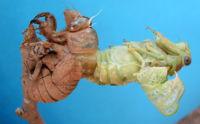You don't smoke a Cigarra but you do smoke a Cigarro.

Spring has arrived in Águas da Prata, SP, Brasil and so have Cigarras (see-gah-has).
I was walking along the street the other day around 5:00 p.m. when I heard what sounded like a peanut vendor. You folks that are too young to remember peanut vendors in Toronto should know that back in the Good 'Ole Days vendors had small carts they pushed around with popcorn, peanuts and candied apples. They had a "steam whistle" that was a very familiar sound, way back in pre history (in the '40's and 50's). The whistle could be heard for blocks.
Well here in Águas da Prata they have something similar. The difference is this whistle is ten times louder and there is no popcorn, peanuts or candied apples.
It is the Cigarras. That is Portuguese for Cicada! One started up in the tree next door to our house and it sounded like a machine starting up. It was very very loud then turned to that shrill steam whistle sound.
Here is what Wikipedia has to say about them.
The cicada (Quesada gigas (Oliver) it is of many insects of the Hemiptera order, Auchenorrhyncha suborder, with small very separated eyes in the very venous head and wings and I am transparent. The cicadas, also called chicharras, live in climates on temperings to tropical.
Here are a few pics of what they look like. I didn't take these pics but rather I got them off the Internet.

Look at the eyes! This is a Black Cicada!
 A Black Buzzer!
A Black Buzzer!
This one looks weird eh?

This is a Cicada opening its wings just as it leaves its underground hiding place.
I hope to actually find one here in Águas da Prata and photograph it to show you. They must be immense here because they make such a loud noise.
More about Cigarras elsewhere:

In this photo released by Brookfield Zoo,
a cotton-top tamarin munches on a cicada turned loose
in its habitat Thursday, May 24, 2007,
at Brookfield Zoo in Brookfield, Ill. Cicadas,
emerging in countless numbers this month
after spending 17 years underground, are more than
just really noisy insects to zoo nutritionists.
They're extremely nutritious and such a welcome addition
to the diets of the animals, the zoo bringing them to the animals
who live inside so they can enjoy them, too.
(AP Photo/Brookfield Zoo, Jim Schulz)
a cotton-top tamarin munches on a cicada turned loose
in its habitat Thursday, May 24, 2007,
at Brookfield Zoo in Brookfield, Ill. Cicadas,
emerging in countless numbers this month
after spending 17 years underground, are more than
just really noisy insects to zoo nutritionists.
They're extremely nutritious and such a welcome addition
to the diets of the animals, the zoo bringing them to the animals
who live inside so they can enjoy them, too.
(AP Photo/Brookfield Zoo, Jim Schulz)
Cicadas a tasty treat for zoo animals
Updated Sat. May. 26 2007 8:58 AM ET,Associated Press
The cicadas are such a welcome addition to the diets of the animals that the zoo is not only letting those that live outside catch and eat them on their own, it is bringing cicadas to the animals that live inside so they can enjoy them, too.
"We've substituted cicadas for crickets and meal worms that some of the other animals get," Sullivan said.
He said that since the cicadas started coming out of the ground in big numbers the last few days, animals all over the zoo have been seen eating them, often as soon as the insects emerge.
The only losers are the cicadas themselves. But Sullivan suggested that if they have to go -- and they are going to die in about 30 days even if they do avoid being eaten -- a zoo is as good a place as any.
"Getting eaten by exotic animals is a better way to go than being eaten by a squirrel or a crow," he said.
Urso Branco














No comments:
Post a Comment